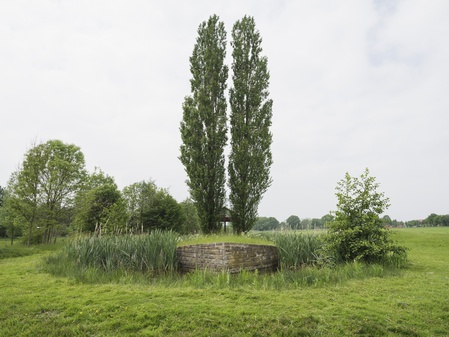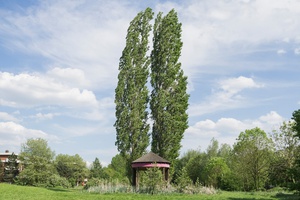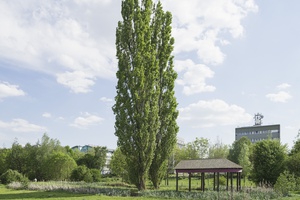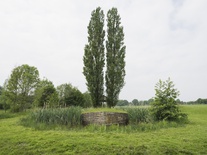Ludger Gerdes
Schiff für Münster [Ship for Münster]
1987
Skulptur Projekte in Münster 1987
Installation consisting of sandstone bricks, wood, and two poplar trees
43 x 5 m, width of moat 4 m, hut 4.6 x 4.2 x 7.4 m
Location
Next to the Kinderbach brook, between Horstmarer Landweg and Mendelstraße, permanent installation
Owner
City of Münster
Ludger Gerdes
* 1954 in Lastrup, Germany
† 2008 near Dülmen, Germany
Ludger Gerdes’ Schiff für Münster [Ship for Münster] is an island in the shape of a ship, constructed from bricks, surrounded by a moat and covered with grass. An architectural construction consisting of wooden columns is located to its stern, which is shaded by two poplar trees in the middle of the island. The installation is sited outside Münster city centre, on its border to the surrounding rural area. This site-specific work was Gerdes’ first for public space: “I believe art should above all serve the function of designing and staging people’s living environments. […] Art should make realistic and constructive proposals which improve the world.”1 Referencing the neglected state of contemporary towns and cities and “dilapidation in the public sphere”2, his installation addresses the relationship between nature and culture.
Today the Schiff für Münster [Ship for Münster] has very much merged with the surrounding nature, with the effect that the column architecture and the rhythmical change of perspective between brook, moat, meadow and area of development has become further emphasised. Likewise the temple architecture has entered into diverse visual and meaningful alliances with the nearby residential houses and commercial buildings. The ship is located on a line of sight to the centre of Münster, originally there was an open view towards the city’s skyline; today however, the view is obstructed by buildings.
Due to its shape the ship is reminiscent of the Dortmund-Ems Canal, the inland waterway. Moreover, it evokes the existential – shipping as a symbol of life perhaps being the most common metaphor. Using narrative within visual language, Gerdes enables his art to experientially connect to the world.3
Stefanie Raupach
1 Ludger Gerdes. In: Dietmar Elger, Ludger Gerdes (Kunst der Gegenwart aus Niedersachsen, publ. by Niedersächsisches Ministerium für Wissenschaft und Kultur, vol. 55), Hannover 2000, 20.
2 Elisabeth Hartung, Künstler. Kritisches Lexikon der Gegenwartskunst, Munich 1991, 3.
3 Christine Tacke (ed.), Ludger Gerdes, exhib. cat.: Kunstraum München, Munich 1990, 5.
Images
Location
- Still existing / Public Collection
- Removed
- In the museum



